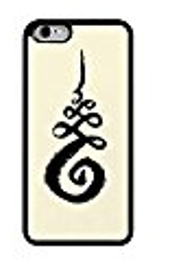Over the years, Buddhism has been significantly disconnected from its religious aspects by the market-driven values of capitalism. Buddhism is represented within specific contexts that relate to mindfulness, meditation, and other alterations that do not necessarily represent the actual religious ideology. This popular association that has been created by advertisers for the purposes of commodification has transformed Buddhism into a resource of imagery and concepts for vendors within the context of a modern marketplace (Wilson 109).
A wide variety of products and businesses openly utilize Buddhism-inspired symbols, terminology, and cultural associations. An investigation showed that the products are not always a part of certain “trends,” with Buddhism symbols becoming such an integrated part of marketing that they have become used for simply decorative purposes. For example, Fig. 1 and Fig. 2 are simple jewelry items that serve no religious purpose or significance, aimed at wearable decorations for women.


However, the company selling the ring actively uses the lotus symbol as its brand logo with an image of a meditating woman in the background. Meanwhile, the pendant product description indicates a metaphorical aspect of the dharma wheel symbol in Buddhism and the “spirituality” it represents.
Fig. 3 which is an incense set and Fig. 4 meditation necklace is the closest products which can be associated with some religious significance. Both items are used in religious practices. However, the aspect of commercialization remains. The product descriptions attempt to establish the origin of the products as countries in Asia with significant Buddhist associations. Furthermore, the products are once again broken down on a symbolic level to indicate how each element represents a specific ancient tradition or ideology within the Buddhist context.


Some products, however, do not focus as much on symbolism as creating a brand or atmosphere around a Buddhist oriented word. Fig. 5 shows a restaurant sign, Fig. 6 is a soundtrack, and Fig. 7 is a yoga wheel. All three of these have one or two words in their title to indicate a connection to Buddhism, but their brand symbols are not recognizable iconic symbols. However, it is evident that the businesses have built a brand around the concept of Buddhism association.



The restaurant has an atmosphere of Asian ambiance with an abundance of Buddhism imagery and artifacts in its decoration that are misused for secular purposes despite the restaurant serving mostly non-Asian foods (Lam). The soundtrack uses the word “zen” and is aimed at meditation practice according to the description. The linguistically ubiquitous use of “zen” has become synonymous with peaceful and focused. It has been created by the dramatic semiotic transformation led by marketing media which sought to establish a brand around this word and other religious terminology (Irizarry, 57).
The remaining products, such as a backpack (Fig. 8), meditation cushion (Fig. 9), and iPhone case (Fig. 10) are essentially the most secular and fundamental commercialization of Buddhism. Businesses producing these goods simply take symbols associated with the religion and place them on any commercially viable product. These have little to no association with religious or cultural affiliations of Buddhism besides popularly commercialized symbols which seem to be used only for decorative and marketing purposes.



These products are aimed at the majority public that is driven by certain “fads” of fascination with Buddhism without having any knowledge or understanding of the religion besides the popularly commercialized symbolic associations. These symbols and impressions are virtually free marketing, resulting in no design or copyright costs for businesses. An appropriation of commercialized Buddhism by the public presents an opportunity for enterprises to profit significantly.
Works Cited
Irizarry, Joshua. “Putting a Price on Zen: The Business of Redefining Religion for Global Consumptions.” Journal of Global Buddhism, vol. 16, 2015, pp. 51-69.
Lam, Raymond. ” The Buddha Image: Branding, Commercialization, Denigration?” Buddhist Door Global. 2014. Web.
Wilson, Jeff. “Selling Mindfulness: Commodity Lineages and the Marketing of Mindful Products.” Handbook of Mindfulness: Culture, Context, and Social Engagement, edited by Ronald Purser, David Forbes, and Adam Burke, Springer, 2016, pp. 109-119.